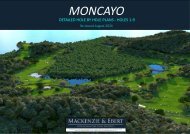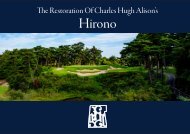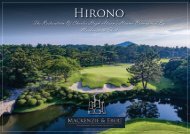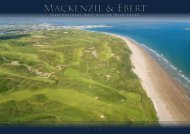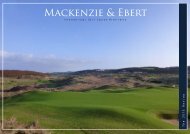Create successful ePaper yourself
Turn your PDF publications into a flip-book with our unique Google optimized e-Paper software.
<strong>The</strong> 1932, 1948, 1963, 1976 & 2015 Aerial Photographs<br />
Historic aerial photographs almost always provide a fascinating insight into the earlier<br />
character and evolution of golf courses. <strong>The</strong>se photographs provide information regarding the<br />
green shapes and sizes, the bunker numbers, locations, sizes and shapes, the fairway widths,<br />
the extent and nature of the rough vegetation, the tree cover and the general landscape.<br />
<strong>The</strong> best photos are ones which are taken from directly overhead and can be scaled for an<br />
accurate comparison with the current day course. At <strong>Hirono</strong>, the earliest aerial photo directly<br />
overhead is from 1948. <strong>The</strong> 1932 photograph was very interesting but was taken at an oblique<br />
angle. <strong>The</strong> 1948 photograph is not very clear so the earliest photograph which provides really<br />
interesting information is from 1963 followed by the one taken in 1976. <strong>The</strong>se are wonderfully<br />
sharp photographs and really show up the greens, bunkers and fairway shapes well. <strong>The</strong>se old<br />
aerial photos illustrate how the course had evolved over the years by our comparison of them<br />
with the most recent aerial photograph of the course available.<br />
<strong>The</strong> main change to the course routing at <strong>Hirono</strong> had been the movement of the 12th green.<br />
This had been pushed further back twice since 1948 and had led to the par 3 13th hole being<br />
completely changed in playing line.<br />
One relatively frequent conclusion of these studies is that green sizes in particular have<br />
become smaller over the years due to a need to reduce the maintenance input as a result of<br />
lower manpower resources during the Second World War. In many cases, their former size was<br />
never recovered. <strong>The</strong>re was definite evidence of this at <strong>Hirono</strong>.<br />
In general, the bunkering layout of the course had remained fairly faithful to Alison’s original<br />
design. A few more had been added and some of the bunkers had seen a significant reduction<br />
in size but this was much less evident at <strong>Hirono</strong> than it is at other courses. Where the bunkers<br />
had changed was in relation to their character, with the roughness and detail being softened<br />
and smoothed out over the years. Examining the great collection of early ground photos of the<br />
course highlighted this.<br />
Another major conclusion at <strong>Hirono</strong> was that the fairways were so much wider in 1963. This is<br />
a common change to courses over the years but perhaps not to the extent that had occurred<br />
at <strong>Hirono</strong>. <strong>The</strong>re was evidence of the fairways becoming narrower between 1963 and 1976<br />
and narrower still after that. As far as the landscape was concerned, the majority of the holes<br />
were tree lined in 1948 but those tree corridors had narrowed considerably over the years.<br />
<strong>The</strong> distant views shown in the early ground photos had certainly diminished as a feature of<br />
the course with the growth of the trees. <strong>The</strong> overall historical review of the course, of which<br />
the aerial photography comparison study was a significant part, proved extremely useful for<br />
the preparation of the Masterplan and as an aid during the construction works. It has also<br />
provided a fascinating historical record for the Club.<br />
1963 Aerial Photograph





